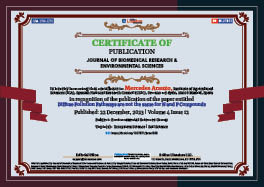Mercedes Arauzo* and Maria Valladolid
Volume4-Issue12
Dates: Received: 2023-12-14 | Accepted: 2023-12-21 | Published: 2023-12-22
Pages: 10.37871/jbres1853
Abstract
Macronutrient fluxes from diffuse sources can affect aquatic ecosystems' health and drinking water quality. These are critical issues covered in the sixth gal of the 2030 Agenda for Sustainable Development to ensure the availability and sustainable management of water and sanitation for all [1]. To promote water quality protection, we need a better understanding of the hydrogeochemical, ecological and anthropogenic factors affecting diffuse pollution by Nitrogen (N) and Phosphorus (P) compounds generated by human activities.
FullText HTML
FullText PDF
DOI: 10.37871/jbres1853
Certificate of Publication

Copyright
© 2023 Arauzo M, et al. Distributed under Creative Commons CC-BY 4.0
How to cite this article
Arauzo M, Valladolid M. Diffuse Pollution Pathways are not the same for N and P Compounds. J Biomed Res Environ Sci. 2023 Dec 22; 4(12): 1689-1691. doi: 10.37871/jbres1853, Article ID: JBRES1853, Available at: https://www.jelsciences.com/ articles/jbres1853.pdf
Subject area(s)
References
- Economic and Social Council of the United Nations. Special edition: Progress towards the sustainable development goals. Report of the Secretary-General. Chapter II: Where we are in the achievement of the Sustainable Development. Goal 6, Ensure availability and sustainable management of water and sanitation for all. 2023.
- European Environment Agency. Agricultural land: Nitrogen balance. Environmental Indicator Report 2017 - In Support to the Monitoring of the 7th Environment Action Programme. EEA Report No 21/2017, Copenhagen; 2017.
- European Environment Agency. Copenhagen: Nutrients in freshwater in Europe. 2023.
- European Environment Agency. European assessment of eutrophication abatement measures across land-based sources, inland, coastal and marine waters. ETC/ICM Technical Report/2016, Copenhagen; 2016.
- European Environment Agency. Source apportionment of nitrogen and phosphorus inputs into the aquatic environment. EEA Report No 7/2005, Copenhagen; 2005.
- Crouzet P, Leonard J, Nixon S, Rees Y, Parr W, Laffon L, Bøgestrand J, Kristensen P, Lallana C, Izzo G, Bokn T, Bak J, Lack TJ, Thyssen N, editors. Nutrients in European ecosystems. Environmental assessment report No 4. European Environment Agency, Copenhagen; 1999.
- Arauzo M, Valladolid M, García G, Andries DM. N and P behaviour in alluvial aquifers and in the soil solution of their catchment areas: How land use and the physical environment contribute to diffuse pollution. Sci. Total Environ. 2022;804:150056. doi: 10.1016/j.scitotenv.2021.150056.
- Poikane S, Kelly MG, Salas F, Pitt JA, Jarvie HP, Claussen U, Leujak W, Lyche A, Teixeira H, Phillips G. Nutrient criteria for surface waters under the European Water Framework Directive: Current state-of-the-art, challenges and future outlook. Sci. Total Environ. 2019;695:133888. doi: 10.1016/j.scitotenv.2019.133888.
- Council of the European Communities. Directive 91/676/EEC concerning the protection of waters against pollution caused by nitrates from agricultural sources. 12 December Official Journal of the European Union L. Brussels; 1991.
- Hinsby K, Markager S, Kronvang B, Windolf J, Sonnenborg TO, Thorling L. Threshold values and management options for nutrients in a catchment of a temperate estuary with poor ecological status. Hydrol. Earth Syst. Sci. Discuss. 2019;9:2157-2211. doi: 10.5194/hess-16-2663-2012.
- OECD. Eutrophication of Waters: monitoring, assessment and Control. Organization for Economic Co-Operation and Development - OECD, Paris; 1984. p.154.
- Arauzo M, Valladolid M. Drainage and N-leaching in alluvial soils under agricultural land uses: Implications for the implementation of the EU Nitrates Directive. Agr. Ecosyst. Environ. 2013;179:94-107. doi: 10.1016/j.agee.2013.07.013.
- Yaron B, Calvet R, Prost R. Soil Pollution: Processes and Dynamics. Springer-Verlag, Berlin; 1996.
- Paltineanu C, Domnariu H, Marica D, Lăcătușu AR, Popa GA, Grafu IA, Neagoe AD. Fertilizers’ leaching from the root system zone - A potential environmental risk for groundwater pollution in coarse and medium-textured soils. Carpath. J. Earth Environ. Sci. 2021;16:139-1590. doi: 10.26471/cjees/2021/016/162.
- Paltineanu C. Nutrient leaching in a cracked vertisol in Romania. Agronomie. 2001;21:427-433. doi: 10.1051/AGRO:2001135.
- Orellana-Macías JM, Merchán D, Causapé J. Evolution and assessment of a nitrate vulnerable zone over 20 years: Gallocanta groundwater body (Spain). Hydrogeol. J. 2020;28:2207-2221. doi: 10.1007/s10040-020-02184-0.
- Richard A, Casagrande M, Jeuffroy MH, David C. An innovative method to assess suitability of nitrate directive measures for farm management. Land Use Policy. 2018;72:389-401. doi: 10.1016/j.landusepol.2017.12.059.
- Arauzo M. Vulnerability of groundwater resources to nitrate pollution: A simple and effective procedure for delimiting nitrate vulnerable zones. Sci. Total Environ. 2017;575:799-812. doi: 10.1016/j.scitotenv.2016.09.139.
- Cameira MR, Rolim J, Valente F, Mesquita M, Dragosits U, Cordovil CMS. Translating the agricultural N surplus hazard into groundwater pollution risk: implications for effectiveness of mitigation measures in nitrate vulnerable zones. Agric. Ecosyst. Environ. 2021;306: 107204. doi: 10.1016/j.agee.2020.107204.






























































